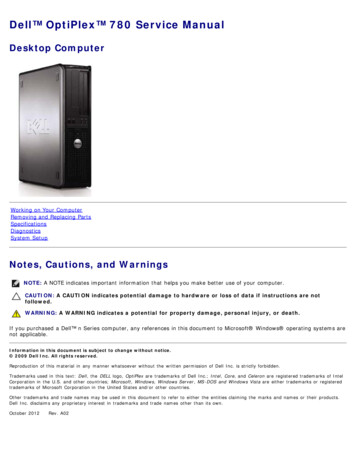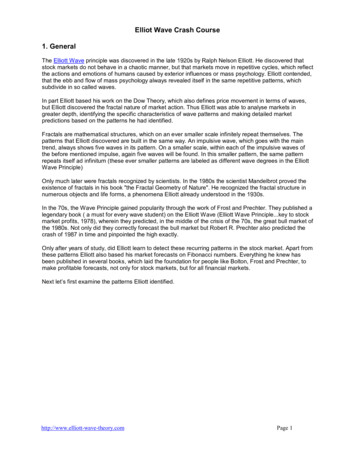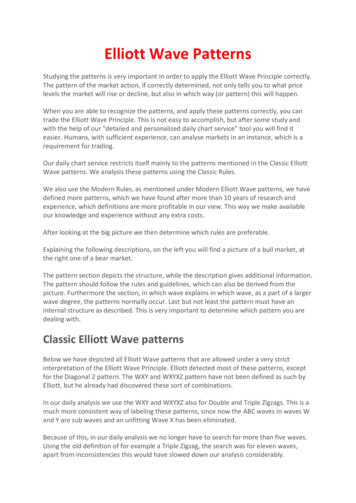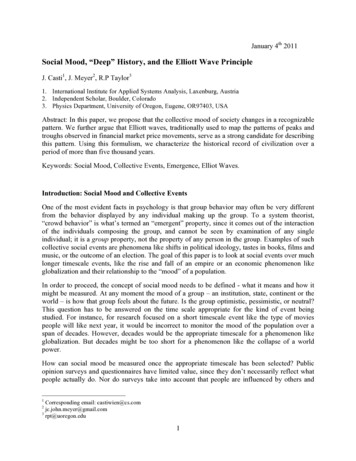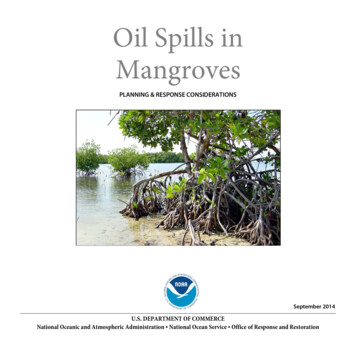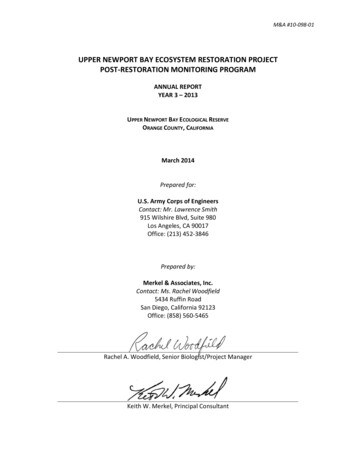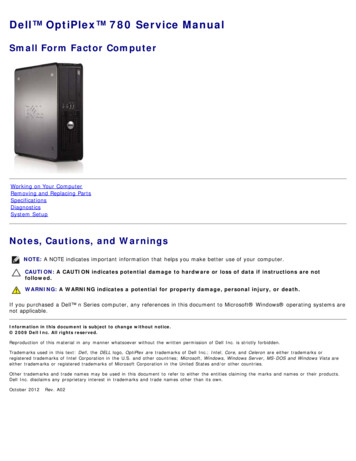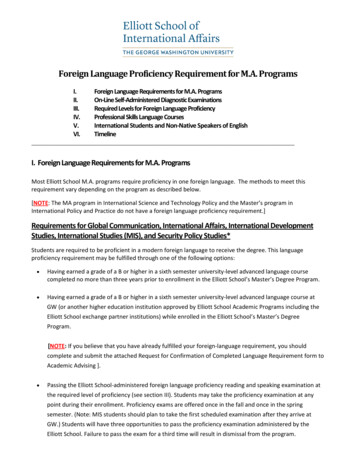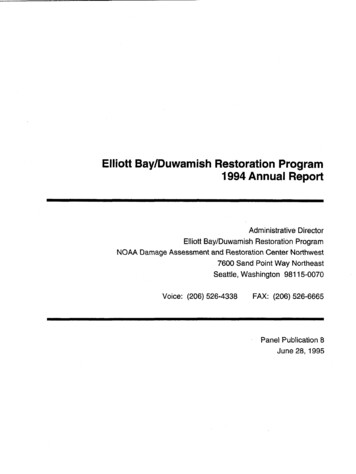
Transcription
Elliott Bay/Duwamish Restoration Program1994 Annual ReportAdministrative DirectorElliott Bay/Duwamish Restoration ProgramNOAA Damage Assessment and Restoration Center Northwest7600 Sand Point Way NortheastSeattle, Washington 98115-0070Voice: (206) 526-4338FAX: (206) 526-6665Panel Publication 8June 28, 1995
Individuals and organizations wishing to receive further information about theElliott Bay I Duwamish Restoration Program should contact the AdministrativeDirector at the following address and telephone number:Robert C. Clark, Jr., Administrative DirectorElliott BaylDuwamish Restoration ProgramNOAA Restoration Center NorthwestNational Marine Fisheries Services7600 Sand Point Way NESeattle, WA 98115-0070(206) 526-4338FAX (206) 526-6665The Panel, its technical working groups and its committees hold regularlyscheduled meetings that are open to the public. Meetings are generally held at theNational Oceanic and Atmospheric Administration, Northwest Fisheries ScienceCenter auditorium, 2725 Montlake Boulevard East, Seattle. Because meetings aresometimes rescheduled and locations changed, the Panel recommends that youcontact Robert C. Clark Jr., Administrative Director, at (206) 526-4338 to confirm themeeting schedule. The Panel also schedules periodic special meetings, such aspublic information meetings and workshops.Regularly scheduled meeting datesPanel: First Thursday of every month, 9:30 a.m.-12:30 p.m.Sediment Remediation Technical Working Group: Second and last Thursday of everymonth, 1-4 p.m.Habitat Development Technical Working Group: Second and last Thursday of everymonth, 9 a.m.-noonPublic Participation Committee: Second Monday of every month, 1:30-4 p.m.Environmental Review of Specific ProjectsFormal hearings and comment periods on appropriate environmental documents foreach proposed sediment remediation and habitat development project will be observed. Please contact the Administrative Director for more information.This information is available in accessible formats upon request at(206) 684-2046 (voice) or (206) 689-3413 (TTY).
ContentsExecutive SUllllllary . 1Elliott Bay /Duwamish Restoration Program Organization . 2Geographic Boundaries . 21994 Program Chronology . 4Public Participation Committee 1994 Summary . 9Habitat Development Technical Working Group 1994 Summary . 11Sediment Remediation Technical Working Group 1994 Summary . 15Elliott Bay /Duwamish Restoration Program Panel1994 Resolutions . 191994 Registry Account SummaryCash Disbursements from the Registry Account 1992 through 1994 . 41In-kind Credits 1992 -1994 . 42AppendixOrganization Plan . A-IFiguresArea Covered by Settlement . 3
Executive SummaryOn March 19, 1990, the United States filed a complaint for the National Oceanicand Atmospheric Administration(NOAA)l acting on behalf of the public as a trusteefor natural resources. The complaint was filed under Section 107 of CERCLA, 42U.S.C. § 9607 (a), to assess and recover damages for alleged injuries to United States'trust resources in Elliott Bay and the Duwamish River. The other natural resourcetrustees who were parties to the Consent Decree were: The U.S. Fish and WildlifeService (USFWS), the State of Washington Department of Ecology (Ecology), theSuquamish Tribe and the Muckleshoot Indian Tribe. The defendants named in thelawsuit were the Municipality of Metropolitan Seattle (Metro), now the King CountyDepartment of Metropolitan Services (Metro), and The City of Seattle (City).The lawsuit was settled by consent decree on December 23,1991. The settlementstipulates that Metro and the City will provide a combination of cash payments, realestate and in-kind services with a total value of 24 million, to be used to clean upcontaminated sediments, to make habitat improvements, and to prevent therecontamination of sediment remediation and habitat projects. The Consent Decreeand a detailed summary of the settlement appear in the Elliott BaylDuwamishRestoration Program 1992 Annual Report, available from the Administrative Director.This annual report summarizes implementation of the settlement during 1994,the third year of the Elliott Bay /Duwamish Restoration Program (Program). ThePanel of Managers (Panel) has identified sites for preliminary investigation forsediment remediation and habitat development projects following substantial publicreview and comment upon the site selection process. The site selection process,public comments, and responses were presented in the final Concept Document,published in June 1994.Activities in 1994 included site investigations, appraisals, site acquisitionnegotiations and conceptual designs for restoration projects in two geographic focusareas (GFAs): Turning Basin Number 3 on the Duwamish River and Kellogg Islandon the Duwamish River. The Panel authorized funds for underwater maps ofpotential habitat development sites within the Elliott Bay GFA that would be used tofurther refine project site areas and to develop conceptual project designs.Data acquisition for the Waterfront Recontamination Study was completed inNovember. Results were scheduled for release in 1995. A scope of work for theDuwamish/Diagonal and Norfolk sediment cleanup was approved and will be usedto select a contractor for the project.lUnited States. et al. v. City of Seattle and Municipality of Metropolitan Seattle, Case No.C90-395WD (W.D. Wash).) [Note: all JI numbers cited refer to this document.]1
The Panel continued to engage in collaborative activities with other governmentagencies and organizations, through cosponsorship of a sediment transport studyand a piling removal workshop.Elliott Bay/Duwamish Restoration Program OrganizationThe Panel was established by the Consent Decree to manage the implementationof the settlement w.iLh Metru and the City. The Panel consists of designated votingrepresentatives and alternates from the parties to the Consent Decree. In 1992, thePanel estahlished the Sediment Remediation Technical Working Group (SRTWG),chaired by Pat Romberg of Metro, and the Habitat Development Technical WorkingGroup (HDTWG), chaired by Curtis Tanner of U.S. Fish and Wildlife Service, toadvise the Panel. Each technical working group includes representatives of thegovernments on the Panel, other governments and agencies, and interested parties.The groups are responsible for identifying potential projects, evaluating themagainst criteria that meet the goals of the Consent Decree and determining theirfeasibility.The Panel established a Public Participation Committee (PPC) to advise the Panelon opportunities for public involvement and educaLlon in all Program activities. ThePPC is chaired by Margaret Duncan of the Suquamish Tribe and staffed byrepresentatives from the Muckleshoot Tribe, NOAA, the City, and Metro.The Panel, the Habitat Development and Sediment Remediation TechnicalWorking Groups, the Public Participation Committee and the AdministrativeDirector comprise the managerial, technical, outreach, and administrativecomponents of the Elliott Bay /Duwamish Restoration Program. The OrganizationPlan, an appendix to this report, provides information on program organization andmembership.Geographic BoundariesThe area covered by the settlement includes Elliott Bay eastward of a linebetween Alki Point and West Point including the shoreline 10 meters upland fromthe mean high water line within Elliott Bay, and the Duwamish River from the rivermouth to the head of navigation (see figure). For purposes of habitat development,the covered area includes tributaries to the Duwamish River.2
Area Covered by Settlement/II A 0 AWASHINGTON3
1994 Program ChronologyJanuary Established an Administrative Record file plan; designated the AdministrativeDirector as file custodian. Approved the 1995 habitat budget for three projects corresponding to the threegeographic focus areas. Tabled the West Michigan sediment remediation site pending additionalsampling for sediment chemistry analysis. Approved the second monitoring plan report for the Pier 53 Sediment Cap andEnhanced Natural Recovery Area Project.February Panel representatives reviewed and commented on compensatory wetlandmitigation for the Department of Transportation (DOT) First Avenue Bridgeconstruction. The project will restore a hydrologic connection between the Marshlocated west of State Route 509 to the Duwamish River. Developed display signs to commemorate the Waterfront RecontaminationStudy. Jointly sponsored a Piling Removal workshop with DOT and the Port of Seattleto develop piling removal methods that minimize sediment resuspension.March Authorized Ecology to prepare the modeling work plan of the WaterfrontRecontamination Study. Approved sampling plans at Diagonal/Duwamish by Metro for: 1) stormwatersampling, 2) bathymetry, and 3) salinity sampling.April Published the 1993 Annual Report. Approved the 1995 Proposed Budget of 1,974,000 as resolution 1994-8.May Identified Problems during Mid-Course Review of the Consent Decree:The Panel identified and discussed some of the operational problemsencountered during its first two years, and agreed to explore administrativeremedies to Consent Decree constraints:1. Need to create a means to allow money from outside sources into theregistry account;4
2. Need to identify flexible procedures tha will enable Metro and the City topropose projects for in-kind services in September of each year, inaccordance with the Consent Decree, amending the proposals onceadditional detail becomes available.3. Need for the budget group (Administrative Director, Metro and the City)to address concerns that the City and Metro are paying in funds at a ratethat exceeds the anticipated rate of payments, given thal the City dndMetro propose to seek in-kind credit for initial projects. Presented Program activitie to the pllhlic at an open house aboard NOAA ShipMcARTHUR on May 21-22 on the Seattle Waterfront during Maritime Week.June Panel Publications:- Public Participation Plan (Panel Publication 6)- The Final Concept Document (Panel Publication 7)- An abridged version of the Final Concept Document as a supplement to thedraft Concept Document with the new sections of the final version.July The Panel continued to monitor mitigation for solvents spilled into marshland inthe vicinity of State Route 509 and the Duwamish River on February 14. Monitored efforts of the DOT to modify Colman Dock renovation plans and toconduct sediment sampling and remediation.August Contacted the Student Conservation Association to assist with plantings andother restoration labor needs. Requested the City to provide an appraisal for the property known as City LightNorth, including (1) the value of the site as it is now, and (2) the value of the siteafter construction of a proposed habitat project to include the daylighting ofHamm Creek and excavation of the river bank on the east side of the parcel. Thelesser amount of 5,000 or half the cost of the appraisal was authorized. Approved a draft Diagonal/Duwamish/Norfolk Sediment Remediation ProjectBudget.5
Hosted Metropolitan King County Councilmember Cynthia Sullivan. As amember of the Water Quality and Habitat Enhancement Subcommittee of theDuwamish Coalition, CowlcilIIl rnber Sullivan encouraged cooperation betweenthe EB /DRP and the Duwamish Coalition, and on the future of King Countyindustrially zoned lands along the Duwamish River given the GrowthManagement Act implementation plans.September The Panel, through Metro, provided a public outreach presentation at theWestlake Transit Station on September 9 as part of Walelweeks aL:tivities. King County Department of Development and Environmental Services held ameeting with various interested parties about thp City Light North habitatdevelopment site. Concerns regarding regulations and shoreline managementgoals under various development scenarios were discussed. Seaboard Lumber site property acquisition negotiations continued. Remainingissues include possible sediment contamination and the development ofprotocols for prepurchase sampling. Presented preliminary results from this summer's field sampling (sedimentphysical description maps) for the Duwamish/Diagonal and Norfolk sites.October The Suquamish Tribe hosted the October 6 Panel meeting at the SuquamishTribal Center. Monitored the Colman Dock sampling results to determine possible impacts tothe Pier 53 Pilot Sediment Remediation Project. Metro and the City agreed to assist the Sediment Remediation Tedulkal Workinggroup to develop source control plan subject to review and approval by thePanp1.November Sampled sediments surrounding the Seaboard Lumber site to assist indetermining the level of contamination on the site. DOT agreed to follow the EB/DRP recommendations for piling removal. Completed the Waterfront Recontamination Study field sampling task. The nexttask is develop information to support remedial investigation, feasibility studies,and site characterizations for waterfront cleanup projects.6
December Determined the primary objective of the Elliott Bay Geographic Focus AreaHabitat Development projects: to enhance habitat from shore areas down to thesubtidal zone to a depth of 60 feet or less. Adopted a scope of work for underwater mapping 0' potential habitatdevelopment areas in the Elliott Bay Geographic Focus Area to be completed byvolunteer divers under the direction of Angela Ferdico. Amended the draft scope of work for the Seattle City Light North appraisal. Thehabitat project would be developed independently from the potentialcombustion turbine. The SRTWG completed a draft Scope of Work for the Diagonal/Duwamish andNorfolk cleanup to initiate selection of a contractor.7
Public Participation Committee1994 SummaryMargaret Duncan, Suquamish TribeThe Public Participation Committee was established to assist the Panel in thedevelopment and implementation of its Public Participation Plan. During 1994, thecommittee continued to support the Panel's public outreach and educationalactivities, guide the development of special materials and project-related documents,and assist with special meetings and collaborative efforts.Public outreach and educational activitiesThe Panel continually seeks opportunities to inform. and involve the public in thePanel's approach to habitat restoration, sediment remediation, and source control.Panel and technical working group members have met with a number of diverseorganizations to describe Panel activities and seek input regarding potential projects.In addition to presentations to such community-based organizations as the GoldenKiwanis, Panel members have also met with University of Washington School ofMarine Affairs and other classes. Other opportunities for meeting with members ofthe public included displays and discussion aboard the NOAA Ship McARTHURduring two days of Maritime Week in May, and participation in Waterweeks inSeptember. Panel and working group members also participated in the Green/Duwamish Watershed Alliance's Summit Conference in October and discussedpotential restoration projects with the Duwamish Coalition.The Public Participation Committee continued to guide the development of factsheets and other informational materials describing the Panel's activities. Thecommittee also updated slides used by Panel members in public presentations todescribe the Panel's goals, structure, and project identification process. Othercontinuous support activities include updating the Panel's mailing list ofapproximately 700 individuals and maintaining the Administrative Record, which isavailable at the NOAA Sand Point offices and the Seattle Public Library's downtownand West Seattle branches.The committee also guided the design and production process for two signscommemorating its Waterfront Recontamination Study and the Pier 53-55 sedimentcapping project. The commemorative signs were produced to fulfill paragraph 17 ofthe Consent Decree, which requires that placards or signs be erected or placed in aprominent location to commemoratp pach sediment remediation or habitatdevelopment project performed under the Consent Decree. The signs will be placed9
in two locations along the Seattle waterfront once permission is secured from theCity to do so.In addition to finalizing the Panel's Public Participation Plan, the committee alsoassisted with the preparation of the public participation components of workplansfor the Diagonal/Duwamish and Norfolk sediment remediation cleanup studyworkplans initiated in 1994. Concurrently, the committee guided the Panel inpmdudu(:; the final Cuncept Document pursuant to public review during 1993. Inaddition to responding to public comment, the document describes the process usedto identify and evaluate potential projects, summarizes the Panel's approach tosource control programs, and discusses the process for environmental review andpublic participation in proposed projects.Collaborative effortsCollaborative efforts with other governments, agencies, and organizationscontinue to be an important component of the Panel's approach to publicinvolvement and education. Monitoring results of the Pier 53-55 sediment caprevealed that piling removal can be a threat to clean up projects because it stirs upcontaminated sediment. To help addr'ess this issue, the Panel joined withWashington State Department of Transportation and the Port of Seattle to co-sponsora workshop entitled "Piling Removal: Environmental Impacts and Solutions." Theworkshop was attended by representatives of federal, state, and tribal resourceagencies, contractors, and local government staff. Due to an interest in potentialwaterfront cleanup, the Panel also initiated a sediment transport study by PatrickMcLaren of Geo-Sea Consulting. The Environmental Protection Agency, the Port ofSeattle, and Washington State Department of Natural Resources/Puget SoundDredged Disposal Analysis assisted with the cost of the study.10
Habitat Development Technical Working Group1994 SummaryCurtis Tanner, U.S. Fish & Wildlife ServiceDuring 1994, the Habitat Development Technical Working Group was primarilyengaged in project development within the three Geographical Focus Areas (GFA)chosen for habitat dpvp10pment projects: the vicinity of Turning Ba.sin No.3, at theupper end of the Duwamish Waterway; the vicinity of Kellogg Island, in the lowerportion of the estuary; and along the shoreline of Elliott Bay, in the nearshoreenvironment of the marine system. The working group also considered themitigation proposal developed by the Washington State Department ofTransportation (DOT) for the First Avenue South project.The Turning Basin GFADuring the early part of the year, the Panel formally notified the City of Seattle ofits interest in pursuing a restoration project at the City Light North itp RE'causeSeattle City Light was conSidering using the site for a combustion turbine (CT),working group members first considered restoration possibilities within the contextof the possible approval and construction of a CT. Seattle City Light officialsreevaluated the original CT project proposal and agreed that it would be possible toreduce the space needed by the CT on the City Light North site. City Light alsoindicated its willingness to reconfigure site plans to accommodate habitatenll.ancement projects at the site, including daylighting of Hamm Creek.The King County Department of Development and Environmental Services wasconsulted regarding the permit process. Concurrently, a formal appraisal of the site,under a variety of development scenarios, was commissioned by the Panel andSeattle City Light. Robert C. Clark, Jr. served as the representative of the Panel in theappraisal process.By mid-year, it was clear City Light officials preferred not to seek Councilapproval for a CT siting before 1996. A decision to proceed on CT projectdevelopment is unlikely prior to 1999 unless the next resource plan confirms theneed for additional generation capacity. Hence, King County Surface WaterManagement, City Light, and working group members continued to considerrestoration possibilities both with and without development of the CT site. Theworking group also continued to develop and refine its comprehensive vision for theTurning Basin GFA, including City Light North and South properties, the CoastalAmerica project, and the Kenco site.11
The vicinity of Kellogg IslandWorking group members continued to consider restoration options within thecontext of acquisition discussions with PacCar for the Seaboard Lumber site onWest Marginal Way Southwest. Kevin Stoops, of the City of Seattle Department ofParks and Recreation was designated as Project Manager. The Corps of Engineerswas authorized to coordinate and manage the Seaboard Site Aquatic HabitatRestoration Analysis regarding areawide and site-specific issues. Limited sedimentchemistry analysis was completed from samples collected near the site to determineambient conditions in this portion of the estuary.The Elliott Bay GFAUnder the guidance of the technical working group, Forsyth Kineon, a NOAAintern at the Restoration Center Northwest, conducted a literature search concerninghistorical conditions, existing habitat conditions and needs, and location and designissues. Due to the lack of existing information regarding location and design issues,and insufficient data regarding habitat conditions and needs within the literature,the working group recommended that the Panel continue to investigate the ElliottBay GFA, and estimated that it would be the last of the three GFAs to be addressedin terms of the implementation schedule. At the close of the year, the Panel approvedthe working groups recommendation that the following three areas be furtherconsidered for habitat restoration work:(a) Myrtle Edwards Park - about 200 yards of shoreline from due west ofLighthouse south past the existing beach and out to about the 100 footcontour;(b) West Seattle from Salty's north about 300 yards along and out to includeEcology's sediment contamination cluster site (EB23); and(c) Smith Cove Park between the dredged Pier 91 channel and Elliott BayMarina.Pursuant to the recommendation of the technical working group, the Panelagreed that baseline studies should be conducted with the assistance from localdiving clubs. Under the direction of Angela Ferdico, the owner of a local divingshop, divers were asked to produce maps and discuss observations regardingsubstrate appearance, contours, and physical and biological features. Working groupmembers llso continued their consideration of artificial reefs, oyster shellenhancement, beach enhancement, and other restoration techniques potentiallyapplicable to the Elliott Bay GFA.12
First Avenue South bridge mitigationA number of consultations between DOT, primarily represented by TomMadden, the project manager for the first Avenue South Bridge project, and workinggroup members occurred concerning the possibility of establishing a direct surfaceconnection between the 509 Marsh and the Duwamish. Ken Pritchard, of Adopt-aBeach, also met with the working group to discuss the problem of Phragmitesinfestation at the 509 Marsh and Kellogg Island.13
Sediment Remediation Technical Working Group1994 SummaryPat Romberg, King County Department of Metropolitan ServicesThe general operating procedure for the Sediment Remediation TechnicalWorking Group (SRTWG) is to review all reports and funding requests related toEB /DRP sediment remediation projects to provide guidance to the Panel andcoordination with other projects in Elliott Bay and the Duwamish River. In 1994 theSRTWG focused primarily on the two sediment remediation projects that werealready approved: the Waterfront Recontamination Study managed by WashingtonState Department of Ecology (Ecology) and the Duwamish/Diagonal and NorfolkCleanup Study managed by Metro and the City of Seattle. The SRTWG also beganwork on goals for Source Control Activities and reviewed monitoring data for thePier 53-55 sediment capping project.Waterfront Recontamination StudyThe Waterfront Recontamination Study is intended to determine whetherpotential cleanup areas along the Seattle waterfront would remain clean or berecontaminated and to provide recommendations for the design of effectiveremedial alternatives. As project manager for the study, Dr. Teresa Michelson ofEcology provided numerous updates to the SRTWG. The study began in 1993 andinvolves one year of data collection followed by data synthesis and modeling ofrecontamination potential. The field work was lead by Dale Norton of Ecology andinvolved deployment of sediment traps at 9 locations during the period fromOctober 1993 to October 1994. Preliminary results showed an appreciable amount ofsediment collected and with elevated chemical levels as measured by the EcologyManchester Laboratory. Current meters with rotors were initially installed at 5locations, but preliminary results showed that the currents in some places were tooslow for the meters to work effectively. Electronic current meters were obtained tomeasure the low velocities and were moved around to provide data from 12locations. Tide changes cause water along the waterfront to move in both directions,but a net flow direction vector was determined by summing results. Preliminaryanalysis indicated that there were local eddies, and it appeared the ferries may havea substantial influence on the local current conditions near the Colman ferry dock.Three sediment cores were collected and analyzed to determine chemical profilesand lead-210 age dating. An inventory was made of existing chemical sources alongthe central waterfront extending from King Street CSO on the south to Denny WayCSO on the north. A final report of the field results will be available in 1995.15
A scope of work for modeling activities for the waterfront was approved afterreview and discussion. However, later in the year there was a reevaluation of theneed for modeling based on results of the field data. Preliminary interpretation ofdata from current meters and sediment traps indicated that ferries and propwashmay have a significant effect on resuspending bottom sediments and are short-livedevents that do not lend themselves to a general waterfront circulation model. It wasalso determined that the remaining point sources WflTf not significantly eliminatingthe need for discharge modeling.An additional component of the waterfront study was a study of bottomsediment movements in Elliott Bay and the lower Duwamish River that was cosponsored by the EB/DRP Panel, the Port of Seattle, Environmental ProtectionAgency, state Department of Natural Resources, Ecology, and the Army Corps ofEngineers. GeoSea Consulting sampled a large grid of more than 500 stations andmeasured sediment particle size distribution. Preliminary results, presented inFebruary 1994, suggested net movement of sand and fines to the south along thewaterfront and up into the Duwamish River. A final report was submitted byMcLaren and Ren (1994).Sediment remediation projects at Duwamish/Diagonal and NorfolkThe Duwamish/Diagonal and Norfolk sediment remediation projects aredirected by Pat Romberg of Metro as project manager, and City of Seattle work isdirected by Bob Chandler. These projects are proceeding according to the proceduresof the Washington State Sediment Management Standards, which require thedevelopment of a formal Cleanup Study Plan consisting of four documents thatundergo public comment. A Work Plan for each site, which was developed underdirection of Dean Wilson, provided pertinent site information plus an explanation ofhow the entire project would proceed. A preliminary schedule was included thatindicated the projects should be completed in 1997. A Sampling and Analysis Planfor each site was developed by Craig Homan, who worked closely with Ecology tofinalize technical issues. A Public Participation Plan for each site was developed byJim Lindler in coordination with the EB /DRP Public Participation Committee. AHealth and Safety Plan that applies to both sites was developed by Jim Faccone.Members of the SRTWG, both individually and as a group, spent considerable timereviewing, discussing, and commenting on these documents to insure they couldserve as a model for other projects. Public review occurred from June 15th to July15th with two letters submitted. Comments were addressed, and Ecology issuedauthorization to proceed with Phase I site assessment sampling in mid-August 1994.16
The budget for Phase I sampling was reviewed and approved by the SRTWG. AtDuwamish/Diagonal there were 35 surface grab stations and one core stationsampled for chemistry analysis. At Norfolk, there were 18 surface grab stations andone core station sampled for chemistry analysis. Metro conducted sample collectionand chemical analysis of most parameters. At both sites, one third of the surface grabstations were evaluated by three separate bioassay tests performed under contractwith Beak Consultants. Quality-assured chemistry data became availablp at the endof 1994. Preliminary
Requested the City to provide an appraisal for the property known as City Light North, including (1) the value of the site as it is now, and (2) the value of the site after construction of a proposed habitat project to include the daylighting of Hamm Creek and excavat

